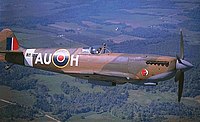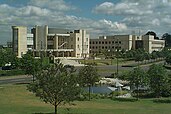| Main page | Categories & Main topics |
|
Tasks and Projects |
The Aviation Portal

Aviation includes the activities surrounding mechanical flight and the aircraft industry. Aircraft includes fixed-wing and rotary-wing types, morphable wings, wing-less lifting bodies, as well as lighter-than-air craft such as hot air balloons and airships.
Aviation began in the 18th century with the development of the hot air balloon, an apparatus capable of atmospheric displacement through buoyancy. Some of the most significant advancements in aviation technology came with the controlled gliding flying of Otto Lilienthal in 1896; then a large step in significance came with the construction of the first powered airplane by the Wright brothers in the early 1900s. Since that time, aviation has been technologically revolutionized by the introduction of the jet which permitted a major form of transport throughout the world. (Full article...)
Selected article
Selected image
Did you know
...that the Heinkel He 46, designed for the Luftwaffe in 1931, was still being used to fight the Soviets in 1943? ...that Pepsi offered a Harrier fighter jet in their Pepsi Billion Dollar Sweepstakes game and the Pepsi Stuff game for people accumulating a certain number of points? ... that Soviet test pilot Vladimir Kokkinaki set twenty aviation world records?
General images -
In the news
- May 29: Austrian Airlines cancels Moscow-bound flight after Russia refuses a reroute outside Belarusian airspace
- August 8: Passenger flight crashes upon landing at Calicut airport in India
- June 4: Power firm helicopter strikes cables, crashes near Fairfield, California
- January 29: Former basketball player Kobe Bryant dies in helicopter crash, aged 41
- January 13: Iran admits downing Ukrainian jet, cites 'human error'
- January 10: Fire erupts in parking structure at Sola Airport, Norway
- October 27: US announces restrictions on flying to Cuba
- October 3: World War II era plane crashes in Connecticut, US, killing at least seven
- September 10: Nevada prop plane crash near Las Vegas leaves two dead, three injured
- August 6: French inventor Franky Zapata successfully crosses English Channel on jet-powered hoverboard
Related portals
Associated Wikimedia
The following Wikimedia Foundation sister projects provide more on this subject:
-
 Commons
Commons
Free media repository -
 Wikibooks
Wikibooks
Free textbooks and manuals -
 Wikidata
Wikidata
Free knowledge base -
 Wikinews
Wikinews
Free-content news -
 Wikiquote
Wikiquote
Collection of quotations -
 Wikisource
Wikisource
Free-content library -
 Wikiversity
Wikiversity
Free learning tools -
 Wikivoyage
Wikivoyage
Free travel guide -
 Wiktionary
Wiktionary
Dictionary and thesaurus
Selected biography
Ballooning was a risky business for the pioneers. Blanchard lost consciousness on a few occasions, endured freezing temperatures and almost drowned when her balloon crashed in a marsh. In 1819, she became the first woman to be killed in an aviation accident when, during an exhibition in the Tivoli Gardens in Paris, she launched fireworks that ignited the gas in her balloon. Her craft crashed on the roof of a house and she fell to her death. She is commonly referred to as Madame Blanchard and is also known by many combinations of her maiden and married names, including Madeleine-Sophie Blanchard, Marie Madeleine-Sophie Blanchard, Marie Sophie Armant and Madeleine-Sophie Armant Blanchard.
Selected Aircraft

The Supermarine Spitfire was a single-seat fighter used by the RAF and many Allied countries in World War II.
Produced by Supermarine, the Spitfire was designed by R.J. Mitchell, who continued to refine it until his death from cancer in 1937. The elliptical wing had a thin cross-section, allowing a faster top speed than the Hurricane and other contemporary designs; it also resulted in a distinctive appearance. Much loved by its pilots, the Spitfire saw service during the whole of World War II, in all theatres of war, and in many different variants.
More than 20,300 examples of all variants were built, including two-seat trainers, with some Spitfires remaining in service well into the 1950s. It was the only fighter aircraft to be in continual production before, during and after the war.
The aircraft was dubbed Spitfire by Sir Robert MacLean, director of Vickers (the parent company of Supermarine) at the time, and on hearing this, Mitchell is reported to have said, "...sort of bloody silly name they would give it." The word dates from Elizabethan times and refers to a particularly fiery, ferocious type of person, usually a woman. The name had previously been used unofficially for Mitchell's earlier F.7/30 Type 224 design.
The prototype (K5054) first flew on March 5, 1936, from Eastleigh Aerodrome (later Southampton Airport). Testing continued until May 26, 1936, when Mutt Summers (Chief Test Pilot for Vickers (Aviation) Ltd.) flew K5054 to Martlesham and handed the aircraft over to Squadron Leader Anderson of the Aeroplane & Armament Experimental Establishment (A&AEE).
- Length: 29 ft 11 in (9.12 m)
- Wingspan: 36 ft 10 in (11.23 m)
- Height: 12 ft 8 in (3.86 m)
- Number Built: 20,351 (excluding Seafires)
- Maximum speed: 330 knots (378 mph, 605 km/h)
- Maiden flight: March 5, 1936
- Powerplant: 1× Rolls-Royce Merlin 45 supercharged V12 engine, 1470 hp at 9250 ft (1096 kW at 2820 m)
Today in Aviation
- 2010 – Lufthansa Cargo Flight 8460, a McDonnell Douglas MD-11 freighter, catches fire and breaks in half as it lands at King Khalid International Airport, injuring the German pilot and co-pilot.
- 2007 – Two TV news AS-350 AStar helicopters collided in mid-air over Phoenix, Arizona, killing all four aboard.
- 2002 – Sknyliv air show disaster: A Ukrainian Air Force Sukhoi Su-27UB crashes during the Lviv airshow killing 85 spectators, 5 of them children. 199 were injured. Pilots managed to eject, but the plane crashed on spectators watching the airshow from the ground. The plane lacked the altitude to escape the crash, and it hit the tribune and fell on the ground. As stated by Ukrainian Defense Ministry, the crash was caused because of engine failure. Pilots, unit commanders later jailed.
- 2001 – First flight of the Sukhoi Su-38
- 1999 – Rollout of the Boeing Business Jet (BBJ). On Oct. 11 Boeing Business Jets will launch the larger BBJ 2.
- 1996 – The final General Dynamics F-111 F attack aircraft are withdrawn from USAF service; on its retirement, the aircraft finally receives an official popular name: "Aardvark. "
- 1989 – Korean Air Flight 803, a McDonnell Douglas DC-10, crashes while attempting to land in heavy fog at Tripoli, Libya. 75 of the 199 passengers and crew on board plus 4 people on the ground are killed in the accident.
- 1983 – First flight of the Embraer EMB 120 Brasilia
- 1982 – A United States Air Force F-5B and a F-5F collide over Tucson, Arizona, three crew ejected but one was killed.
- 1982 – A USAF Sikorsky HH-53C, 69-5792, (conflict here—second source lists it as 69-5782) from the 1551st CCTW at Kirtland AFB, New Mexico, crashed following a descent from a night time refueling mission, four killed.
- 1971 – Indian Air Force production HAL HF-24 Marut Mk.1, flown by Wing Commander J. K. Mohlah, crashes just after takeoff at Bangalore, pilot KWF.
- 1965 – American aircraft strike a surface-to-air missile site for the first time, attacking an SA-2 Guideline site in North Vietnam.
- 1963 – United Arab Airlines Flight 869, a de Havilland Comet 4C, crashes into the sea while on approach to Bombay Airport, India, killing all 63 on board.
- 1961 – During Arctic ASW reconnaissance, Bill Misener and crew of 415 Squadron flew Argus 20722 for 30 hours and 20 min.
- 1960 – North American F-100C Super Sabre, assigned to the USAF Thunderbirds on 28 March 1960, is destroyed this date during a solo proficiency flight when it crashes fifty miles from Nellis AFB, Nevada, killing Capt. John R. Crane.
- 1956 – IvA USAF Boeing B-47E-130-BW Stratojet, 53-4230, of the 307th Bomb Wing from Lincoln AFB, Nebraska, crashes while making touch-and-goes at RAF Lakenheath, skidding off runway and into nuclear weapons storage igloo holding three Mark 6 nuclear bombs, burns. No weapons in the facility go off and all are later repaired. Stratojet was unarmed.
- 1955 – El Al Flight 402, a Lockheed L-049 Constellation, inadvertently strays over Bulgarian territory on its way from Vienna to Tel Aviv, and is shot down by two Bulgarian fighter aircraft, killing all 58 on board.
- 1954 – Second prototype Avro Vulcan, VX777, suffers substantial damage when it swings off runway upon landing at Farnborough. It will not fly for six months.
- 1953 – The Korean War ends.
- 1950 – RCAF moved in support of United Nations action in Korea. No. 426 (Transport) Squadron began airlift of supplies to Tokyo, Japan.
- 1949 – First flight of the de Havilland Comet
- 1947 – First flight of the Bristol Sycamore
- 1947 – First flight of the Tupolev Tu-12
- 1946 – First flight of the Supermarine Attacker
- 1944 – Introduced: Gloster Meteors of No. 616 Squadron RAF fly their first V1 interception mission
- 1943 – (Overnight) – 787 British bombers attack Hamburg, with a loss of 17 aircraft. Atmospheric conditions create a self-propagating tornadic firestorm with winds of 150 mph (240 km/hr) and flames reaching 1,000 feet (305 m) in altitude, resulting in one of the most destructive air raids in history. Air temperatures reach 1,500 degrees F (850 degrees C), causing asphalt in city streets to catch fire. At least 40,000 people die in the raid and 1,200,000 flee the city, which does not regain its previous industrial capacity for the rest of the war. The raid shocks Germany.
- 1942 – F/S G. F. Beurling downed four enemy aircraft while serving with the RAF in Malta.
- 1939 – The first of 38 B-23 Dragons built flew.
- 1937 – First flight of the Focke-Wulf Fw 200
- 1934 – First prototype Messerschmitt Bf 108A, D-LBUM, accepted by the Luftwaffe for competition flying, crashes, killing the pilot, a member of Erhard Milch's staff at the Reichsluftfahrtministerium (Ministry of Aviation).
- 1931 – The Air Line Pilots Association of the USA is formed.
- 1929 – Western Canada Airways pilot W. L. Brintnell flew a Fokker F. VII/3 M from Vancouver to Winnipeg 10 hours, 30 min.
- 1928 – The Boeing Model 80, a 12-passenger trimotor biplane transport, makes its first flight. The design is upgraded to the 18-passenger Model 80 A, which makes its first flight a year later.
- 1923 – A Navy Cox-Klemin XS-1 was the first airplane launched from a submarine.
- 1923 – Edward Stinson lands his Junkers at Mitchell Field in New York after making the first non-stop flight from Chicago.
- 1920 – Radio compass used for first time for aircraft navigation.
- 1912 – Lieutenant John Rodgers and Ensign Charles Maddox, in a Wright B1 Flyer, send the first wireless message from an airplane to a ship, the torpedo boat USS Stringham, stationed in Annapolis, Maryland.
- 1909 – Orville Wright makes the first official test flight of the U. S. Army’s first airplane in Fort Myer, Virginia. President William Howard Taft, his cabinet, and 10,000 spectators witness the flight. The flight lasts 1 h 12 m 40 s.
- 1901 – Wilbur and Orville Wright make the first of a series of test glides at Kill Devil Hills near Kitty Hawk, North Carolina. Their redesigned biplane glider No. 2 has a larger wing area and wing control worked by a pilot’s hip-cradle device.
References
- Shortcuts to this page: Portal:Airplanes • P:AVIA
Purge server cache














































Recent Comments